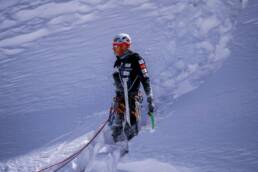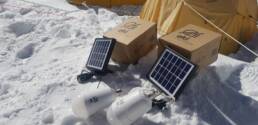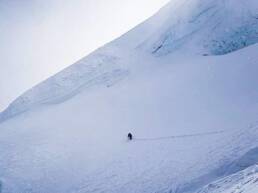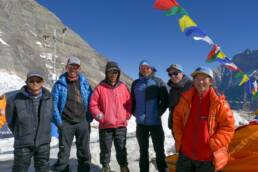The luxury of being able to share this adventure with Iñaki
Most of you will not know Iñaki but we have had the luxury of being able to share this project with him. Iñaki Álvarez, a Gipuzkoan from Zumarraga with a passion for history and archeology, is a calm, silent man. His humility is on par with the enormous illusion that he has put into this adventure from the first minute when Alex told him if he wanted to come to Manaslu with us. Iñaki had already been on expedition with Alex 20 years ago together with Jon Maroto and Xabier Ormazabal. Of the 4 who made up that expedition, only Iñaki and Alex are still alive.
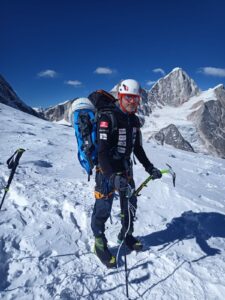
Just a few months ago he told us about the relationship he has had with the mountain throughout his life. Here we post a brief text he wrote us just a few weeks before leaving.
“The mountain is a passion that I have inside since my youth. This has led me to climb far mountain ranges throughout my life. I perfectly remember my first experience with "altitude sickness", it was on Mont Blanc on the Grands Mulets route in 1999, if the first day we went down dizzy the second we insisted on climbing to the top. That same year I saw a mountaineer die for the first time, he was climbing Hornli ridge to the Matterhorn. Later I also climbed the Lyon ridge to this same peak and many other routes such as the Mitellegui to the Eiger, the east spur to the Ober Torberg, Dent du Geant, Weisshorn etc.
In 2001 it was my first experience above 6000 meters, and the first time I saw frostbite, on my friend Jon Maroto's fingers, after coming down from Huascarán. I travelled to Peruvian Andes (Cordillera Blanca) and Bolivians (Cordillera Real) in different years to climb other peaks such as Toclaraju, Huaina Potosi or Illimani.
I visited the African continent in 2008 with my friend Koke Lasa to go to the Atlas Mountains, where we climbed several peaks, including Toubcal on the corridor route. But the top of that activity was the ascent to Biiguinoussene (4002 m) by a new route, which we did not see cataloged, and about which we did not give news. I'd say it was a D + grade.
My trip to Pamir in 2002 was quite an experience and a high mountain lesson that I will not forget. There I met Alex Txikon, and although we did not summit, our friendship lasts, so that is what I took back home from that great mountain.
Perhaps the top of my humble alpine career would be the expedition to Shisha Pangma in 2004, since we left aside the normal route to climb the central corridor of its north face, of a thousand meters with about 55º maintained, which led directly to the top . It was opened in 1987 and we entered that year after being first promoted by our friends Unai Pérez de Arenaza and Oriol Baró, who encouraged us to climb that huge ice slide".
Thanks Iñaki for being up there taking care of Alex and the rest of the team.
EKI-SOS Himalaya: a high-altitude collaboration
The expedition we are carrying out this year has a marked humanitarian and solidarity value. I always try to make it that way, but this year it had to be more than ever. The pandemic generated by COVID-19 has hit all of Nepal very hard. Not so much at contagion level, but at economic level. The people here live largely from tourism and this year, as we all know, we have hardly been able to move from our countries. When I spoke with them on the phone before coming, they all passed the same idea to me: “We are suffering a lot. Everything is stopped and this is unsustainable. People are having a very bad time ”. Worry invaded his words.
I knew, therefore, what we were going to find. This is why, together with EKI Foundation, we got down to work. We had to think about how we could help them. Always within our means, of course. We are a committed but very small team with limited resources. But we had to find the formula. There are no excuses here. Nepal has given me so much and I always feel that I am indebted to them… In a way, I owe it to them.
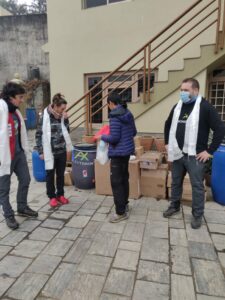
Well, after looking for formulas with EKI Foundation, we thought we could help them in two different ways: by giving them 60 autonomous light bulbs and by giving them the solar panels we have brought to Manaslu base camp that provide us with all the energy we need in our daily life.
But we needed to put a third protagonist into the equation. Someone to tell us where and to whom to deliver material. Someone who knew first hand and better than anyone Nepalese people’s needs. And here it’s where Iñaki Ochoa de Olza-SOS Himalaya Foundation came in. We got in touch with them and everything was very simple. Our job would be to receive EKI Foundation material and take it to Nepal. So we did it.
During our first week in Kathmandu we met with them and delivered the first batch of products: 60 autonomous LED bulbs, which can work thanks to a solar panel attached to them or which, if desired, can also be turned on with normal electricity (although cuts, as is common in some areas). That is to say, these bulbs have a lithium battery that is charged thanks to the sunlight or the electricity that can arrive. If it gets dark or the power supply goes out, the battery is charged and the bulb continues to work for up to 8 hours. A simple system, but extremely effective. In addition, these bulbs have a USB input and a microjack and the system can be activated with a remote control. A light bulb in a home can mean that girls and boys can study, that their day does not finish with the night.
Once we finish our expedition in Manaslu, we will deliver the second batch of material: solar panels that supply us with energy in base camp and prevent us from having to use generators and consume fuel (without forgetting the environmental impact we are avoiding). But first we have the challenge of climbing a giant of 8,163 meters, and it is not being so easy for us. Eskerrik asko to Iñaki Ochoa de Olza SOS Himalaya Foundation for helping us bring all this material to the areas where it is most needed and to Fundación EKI for making it possible. We are getting renewable energy to reach the most remote places on the planet and helping many families to improve their lives.
The payoff after hard work
We're destroyed. They have been days of a lot of work. As you know, a huge rimaye made us change our plans and that has made the climb very difficult. But it was worth it. The peace of mind that gives you having done an incredible job like the one we have done is very comforting. In addition, on a new route. Few more satisfying things like this one, really. The immensity of the place, so white and silent, the 'mushrooms' and 'popcorns' that we have found up there… it has been beautiful. We have suffered a lot, but we have enjoyed it much more. I am very proud of the team. Everything we have done is exciting. We can see the north peak of Manaslu very close! We have equipped almost up to 6,700 meters and we brought up quite all the necessary equipment for summit attack.
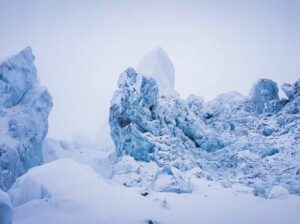
We had to equip the route for 3 intense days. It was new to us. We believe that no one has ever climbed it. In the absence of information, Chhepal, Kalden, Namja and I had to work hard to equip it little by little. Step by step, but without rest. We equipped much of the track between the four of us. On the other hand, Iñaki was in charge to carry up two good material cargos and Simone, Tenzing and Gelum equipped 350 meters of rope, from 6,325 meters to 6,450 meters. They continued what we started. Simone has also done an important job bringing up the rest of the material needed for summit attack to 6,650 meters. A 20 kilos backpack, almost nothing.
They have been days of many ups and downs. We even think about having to turn back to Bilbao at some point due to the difficulties we has. That rimaye could have been decisive, but we overcame the obstacle. With sacrifice, commitment and a lot of desire. But, above all, with a tremendous psychological work. The mountain forces you to do it, and I think we have far exceeded it.
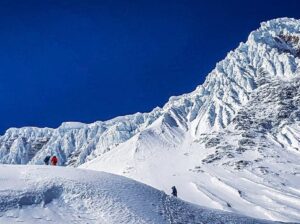
Now it's time to rest for a few days. But as weather permits, we are going up. We are quite optimistic and I think we made a lot of progress. The next step will be tough. Very hard. And, again, the mountain will test us. As it always does. But we are prepared.
The Sherpas, essential protagonists in our expeditions
Sherpas are, without any doubt, essential protagonists in all our expeditions in the Himalayas. Without them, it would be impossible for us to face challenges we purpose . Of course, Manaslu-EKI is no exception. They’re having a very important part in equipping the new route we are opening.
I would like, first of all, to thank this group that has suffered so much from the pandemic generated by COVID-19. The restrictions due to epidemiological situation around the world have stopped the majority of expeditions scheduled for this year . As you well know, also for us it’s been really hard to travel to Nepal. We sweated a lot to be able to organize everything, get all the papers the local authorities demanded us and, finally, spend a quarantine that delayed all our plans. As I told you, all these complications have made many people decide not to come this winter.
All these Sherpas live largely off people like us and tourists. Their main sustenance is expeditions and in 2020-2021 there have hardly been any. I was talking to you in another recent post about what several people told us during the trek to base camp: “you are one of the very few foreigners we have seen in recent months. Very few people have come since March and that for us is devastating ”. A heartbreaking message that makes us very sorry. We hope the situation changes as soon as possible and these people, like those of this entire region, will once again have a reliable income so that they can live in the most dignified way possible.
Having said all this, I would like to tell you about three Sherpas who are accompanying us on this adventure: Chhepal Sherpa, Kalden Sherpa and Namja Sherpa. Three wonderful people who are also magnificent professionals. Honestly, without their help and experience, all this we are experiencing would not have been possible. Namaste!
Cheppal Sherpa is the one who has been with us the longest. Since we tried to ascend Everest in winter, it has accompanied us on all our expeditions. He is the oldest of all and does the work of leader of the Sherpa team. He is a spectacular person, kind and polite. But above all, he is a machine in the mountains. His experience is fundamental to us and he works hard. The truth is that he leaves no one indifferent. Everyone who knows him I am sure will remember him all his life.
Kalden Sherpa started with us last year at Ama Dablam (the main peak is 6,812 meters above sea level). He is a very strong and daring person. A man of few words, one of those who find it difficult to get out what he has inside but, once you establish a relationship with him, he is a very nice and close person. If I had to highlight something about him, I would say he is very willing, that he never spare efforts. He has no problems working and that is very much appreciated when the moment of truth arrives.
The last of the protagonists is Namja Sherpa, a new member we have incorporated this time. Without a doubt, another 'machine'. What has impressed me the most is his physical strength. He is very strong. My friend Lur, whom I send a greeting from here and who had to leave the adventure earlier than we would have liked, was scared by his ability: “how this guy works, Alex. He has an incredible physical shape ”. He may know something about all this too. Welcome to the team, Namja, and a big thank you to all of you.

